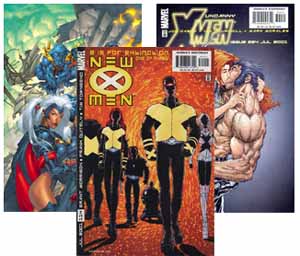|
|
|
New X-Men writers chart course for Marvel's mutants May 24, 2001 By Franklin Harris It's hard to know what to make of the new X-Men. The spandex costumes are gone. Now Marvel Comics' mutant heroes dress much like their counterparts from last year's movie. "I was never sure why you had us dress up like superheroes anyway, Professor," Beast says in "New X-Men" No. 114. To which his teammate Cyclops replies, "The Professor thought people would trust the X-Men if we looked like something they understood." That sums up the change the X-Men have undergone. And it sums up the attitude of most comics fans, who, in the past 30 years, have all but ignored non-superhero comics.
The X-Men remained that, for the most part, even when Chris Claremont became the writer of "Uncanny X-Men" in the '70s. During Claremont's long tenure, the X-Men took part in more epic adventures. They went into space, visited alternate dimensions and traveled through time. The idea of anti-mutant prejudice was certainly still around, personified by the anti-mutant politician, Sen. Kelly. But the X-Men still looked and behaved like superheroes. Now, with Marvel's blessing, writer Grant Morrison is doing away with the superhero trappings. In their place, he is setting up a struggle between humanity and mutants that mirrors the evolutionary struggle between Neanderthals and the Cro-Magnon (our ancestors) thousands of years ago, with humanity destined to be on the losing side. "More and more of us all the time," says Professor Xavier, the X-Men's founder. "I wonder what it means?" From the looks of it, it means Morrison's X-Men will be too busy defending their fellow mutants from humanity to spend much time protecting anyone else. All this brings me to the newest X-Men comics. Arriving in comics shops last week was Morrison's "New X-Men" No. 114, which sets up everything I've mentioned so far. And it is by far the strongest of the three core X-books, if the first issues of the new regime are anything to go by. Frank Quitely (not his real name), fresh off a stint drawing another unorthodox superhero comic, "The Authority," handles the art chores, with an assist from inker Tim Townsend. Clearly, Morrison's vision of what the X-Men should be is dominant, and his book has the strongest sense of purpose. It's that sense of purpose that seems most lacking in Joe Casey's first X-Men issue, "Uncanny X-Men" No. 394. Casey's stand-alone story doesn't appear to set anything up, and it doesn't even feature most of the X-Men who will make up Casey's regular cast. Even as a stand-alone, Casey's story, about a young mutant who decides to go out in a blaze of glory, is only fair to middling. The real star of the book is penciller Ian Churchill. While Churchill's style, very much in the Image Comics mode, is becoming outdated, it is at least prettier than Quitely's. In fact, it seems there is an inverse relationship between the quality of the writing on the X-books and the quality of the art. Salvadore Larroca of "X-Treme X-Men" is probably the best artist of the three, but Claremont's story for "X-Treme X-Men" No. 1 is the most wanting. "X-Treme X-Men" is Claremont's consolation prize for being unceremoniously dumped from the two main X-books. Unfortunately, it has most of the flaws that characterized Claremont's brief and unsuccessful return to the books he made bestsellers. "X-Treme X-Men" No. 1 is cram- med with useless exposition, mostly involving various X-Men explaining who the are and what they can do. I assume Claremont intends all the excess verbiage to help new readers figure out what is what, but it comes across as clumsy. I can't recommend "X-Treme X-Men" to anyone other than die-hard Claremont fans. But "New X-Men" is a must buy and "Uncanny X-Men" is worth a look. That means there are at least two X-Men comics worth reading, which is two more than there were last month. |

RECENT COLUMNS
Order a helping of Cartoon Network's 'Robot Chicken'
03/31/05
Campaign against video games is political grandstanding
03/24/05
Prize-winning author is 'Wrong About Japan'
03/17/05
Censored book not a good start
03/10/05
Some superhero comics are for 'fanboys' only
03/03/05
'Constantine' does well with its out-of-place hero
02/24/05
'80s publisher First Comics' legacy still felt
02/17/05
Director's cut gives new 'Daredevil' DVD an edge
02/10/05
Put the fun back into 'funnybooks'
02/04/05
Is 'Elektra' the end of the road for Marvel movies?
01/27/05
'House of Flying Daggers' combines martial arts and heart
01/20/05
Anniversary edition of 'Flying Guillotine' has the chops
01/13/05
Movie books still have role in the Internet era
01/06/05
Looking ahead to the good and the bad for 2005
12/30/04
The best and worst of 2004
12/23/04
'Has-been' Shatner is a 'transformed man'
12/16/04
© Copyright 2005 PULP CULTURE PRODUCTIONS
Web site designed by Franklin Harris.
Send feedback to franklin@pulpculture.net.
